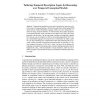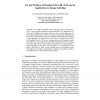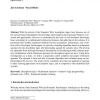145
click to vote
FROCOS
2011
Springer
14 years 2 days ago
2011
Springer
Temporal data models have been used to describe how data can evolve in the context of temporal databases. Both the Extended Entity-Relationship (EER) model and the Unified Modelli...
153
click to vote
DLOG
2011
14 years 3 months ago
2011
W3C currently extends the SPARQL query language with so-called entailment regimes, which define how queries are evaluated using logical entailment relations. We describe a sound a...
126
Voted
DLOG
2011
14 years 3 months ago
2011
A combination of open and closed-world reasoning (usually called local closed world reasoning) is a desirable capability of knowledge representation formalisms for Semantic Web app...
111
Voted
DLOG
2011
14 years 3 months ago
2011
Abstract. In this paper, we introduce a paraconsistent extension of Rough Description Logics which allows the representation of incomplete and contradictory concepts, as well as th...
210
Voted
DLOG
2011
14 years 3 months ago
2011
This paper examines a new technique based on tableau, that allows one to introduce composition of roles from the right hand side of complex role inclusion axioms (RIAs). Our motiva...
151
Voted
DLOG
2011
14 years 3 months ago
2011
Evolution of Knowledge Bases expressed in Description Logics (DLs) proved its importance. Most studies on evolution in DLs have focused on modelbased approaches to evolution semant...
154
Voted
DLOG
2011
14 years 3 months ago
2011
Abstract. For a number of problems, such as ontology learning or image labeling, we need to handle uncertainty and inconsistencies in an appropriate way. Fuzzy and Probabilistic De...
114
click to vote
DLOG
2011
14 years 3 months ago
2011
We introduce an extension of Description Logics (DLs) for representing and reasoning about contextualized knowledge. Our formalism is inspired by McCarthy’s theory of formalizing...
107
Voted
DLOG
2011
14 years 3 months ago
2011
This paper introduces relaxed abduction, a novel non-standard reasoning task for description logics. Although abductive reasoning over description logic knowledge bases has been ap...
99
Voted
ML
2010
ACM
14 years 7 months ago
2010
ACM
With the advent of the Semantic Web, description logics have become one of the most prominent paradigms for knowledge representation and reasoning. Progress in research and applica...



